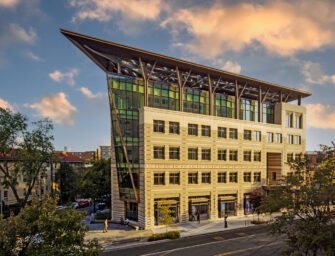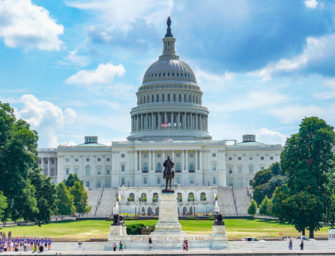AGU Council Meeting Summary
By Jenny Riker, Geology Teaching Fellow, University of Bristol; AGU Council Member
Last week, AGU’s Council had its first meeting of 2016. A member of the Council Leadership Team is asked to share reflections at the close of each meeting.
We are now past the midpoint of our two-year terms, and with tangible momentum, we dove into a substantial agenda covering everything from emerging science to key AGU activities to ethical considerations surrounding sexual harassment and corporate partnerships.
From Council member Geoff Plumlee, we learned about the crossover between earth science, human health, and environmental health reflected in the emerging field of geohealth. Publication output and funding for geohealth research are increasing, and geohealth content at AGU’s own meetings is on the rise. The Council sees the need for transdisciplinary research in this growing field and many opportunities for AGU to make an impact. Importantly, these opportunities are well-aligned with aspects of our mission: to lead the advancement our science, foster talent pool development in emerging fields, and to use our science to benefit society. (From the Prow, 15 November 2015)
The Council also received an update on AGU’s meetings strategy from Rick Murnane, Chair of the Meetings Committee, which undertook a thorough review of our meetings portfolio last year. Rick asked us to consider how four key meeting components – their purpose, participation, content, and connection to other AGU activities – could better support AGU’s strategic plan. A few themes emerged:
presentation formats that foster the two-way exchange of ideas
time and support within meetings for informal scientific interactions
formats and activities that help large meetings feel smaller
a desire for a meeting that more fully reflects the global nature of AGU
improved leveraging of public outreach opportunities
meetings becoming a key part of a sustained exchange of ideas, building and maintaining momentum before, during and after the meeting
In 2019, AGU will celebrate its 100th birthday, and the Council provided input on activities for the upcoming Centennial. The Centennial presents an unparalleled opportunity for massive engagement of scientists and non-scientists alike, and the Council focused on activities that would have the broadest reach and most lasting impact. We discussed ways to honor the discoveries and innovations of the last century, such as the development of the theory of plate tectonics, whilst looking ahead to what we might achieve in the next hundred years, such as understanding and managing the human influence on earth processes. We noted the long and accelerating trend of the increasingly interdisciplinary nature of our work.
Council members heard from the Affiliation and Engagement Task Force on ongoing efforts to understand how our organizational structure could be modified to better enable people to collaborate or connect to others with shared interests and aims. At the broadest scale, our ability to affiliate and engage affects how we do our science, run our meetings, interact with non-members, honor achievements, and self-govern. The task force has reviewed AGU’s current structure and envisioned a spectrum of alternate models for the future – from small tweaks to complete re-imaginings. They are now ready to pilot engagement activities with groups seeking an improved connection with AGU, including Earth science educators and those working at the intersection of science and art.
In addition to updates on AGU activities, the meeting’s agenda touched on several challenging ethical issues, including AGU’s role in preventing and addressing sexual harassment (From the Prow, 22 January 2016). Our current ethics policy is silent on sexual harassment, while our existing codes of conduct, which do address sexual harassment, apply only to behavior at meetings. Council members discussed a range of possible actions, from updating the ethics policy to providing training for members, to partnering with external organizations that could provide a safe haven for reporting. We also discussed how AGU could (and should) take a proactive role in addressing sexual harassment in the scientific community.
Perhaps as important as the discussion itself were our reactions to it. At times, jaws literally dropped. While sexual harassment is by no means exclusive to women, I am sure that almost every woman in the room could say, “I could tell you a story….” With this in mind, I urge all of us – members, leadership, and staff – to take this matter seriously as the Ethics Committee continues its work.
Finally, the Council addressed a recent request from members and non-members for AGU to sever ties with Exxon Mobil (From the Prow, 22 February 2016). Specifically, the Council was asked to consider Exxon’s current positions and statements in light of our recently approved organizational support policy, as well as the pros and cons of maintaining or ending such a partnership. These questions triggered spirited discussion, and the Council expressed a range of opinions as varied as those that have been expressed by members. These views range from severing ties to always keeping open a big tent, with several nuanced positions in between involving degrees of engagement. These exchanges were not trivial – my own opinion swayed more than once when confronted with new perspectives. Moreover, our debate provided a jumping off point for a broader discussion of the nature and purpose of corporate partnerships. Could AGU better engage its industry partners to foster more effective scientific dialogue at the highest levels? Our collective input will be forwarded to the Board of Directors, who will meet to consider these issues further next month.
Our conversations around sexual harassment and corporate partnership drew intriguing parallels. Where is the boundary between behaviors that compel AGU to act, and those that do not? Should we distinguish between past and present behavior? Who judges whether behavior is ethical, and how do we identify (and verify) behavior in conflict with our policies? How can we best enforce our policies? Science and ethics are linked and will remain so. These are the types of questions AGU will need to address and revisit now and in the future.
Last week’s Council meeting had all the hallmarks of good science: mindful of the past yet forward-thinking, collaborative, impactful, and open to change. AGU’s members and leaders continue to push the boundaries of what a scientific society can achieve, and the Council works hard to ensure that, as a whole, AGU remains greater than the sum of its parts. For me, it is a pleasure to aid in this effort.




There are no comments
Add yours